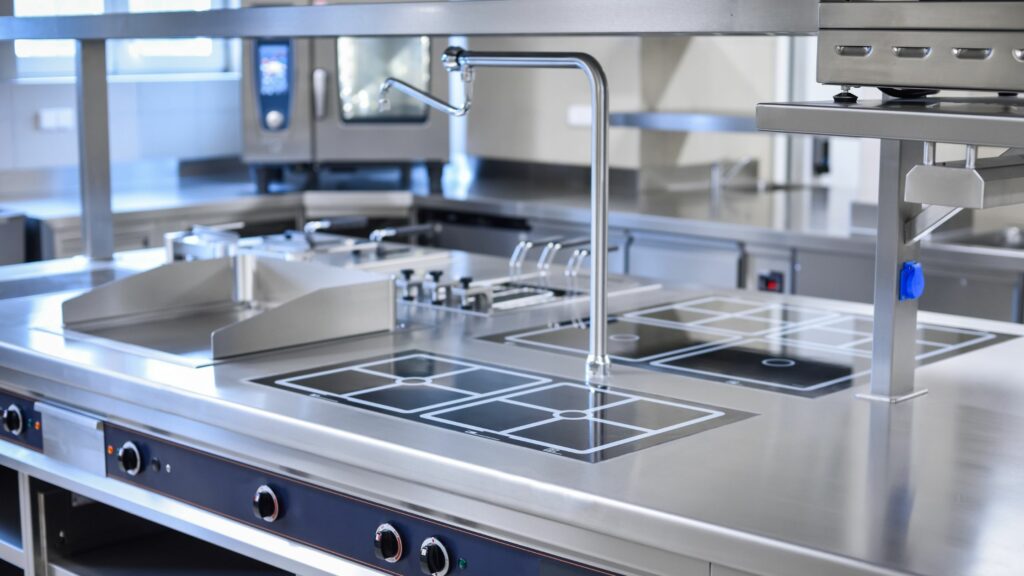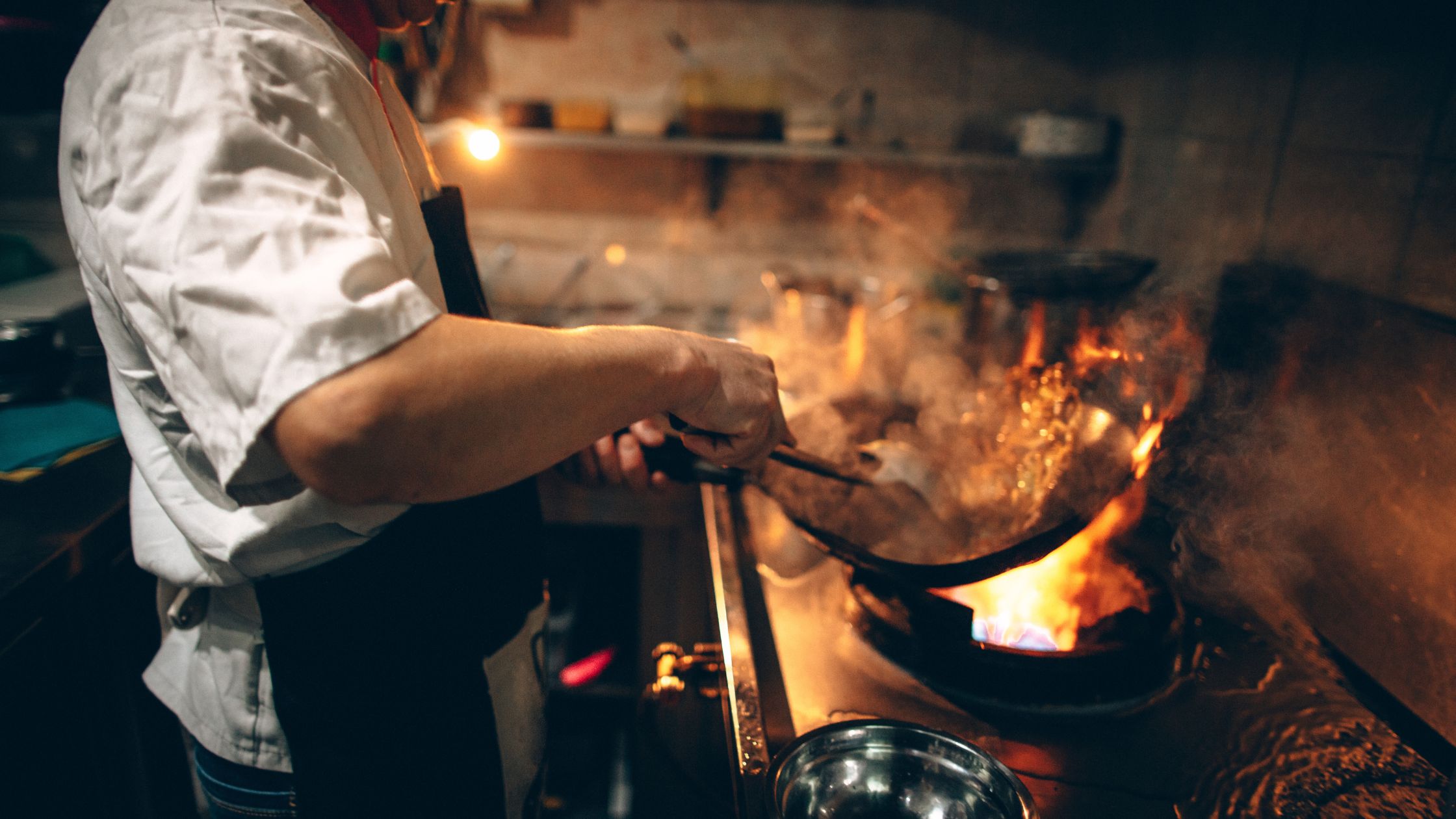Are you intrigued by the concept of ghost kitchens and their impact on the UK food industry? Ghost kitchens, also known as virtual or cloud kitchens, are a growing trend transforming food preparation and delivery. These professional kitchen facilities operate without traditional dine-in spaces, focusing solely on delivery and takeout orders. In this article, we will explore the key steps for success in the ghost kitchen business, from grasping the concept to establishing and implementing a business model.
If you’re contemplating setting up a ghost kitchen, vital considerations include finding the right kitchen space, crafting a menu tailored for delivery, and recruiting and managing kitchen staff. These factors are pivotal in ensuring the smooth operation and success of your ghost kitchen venture. Join us as we delve into essential steps for establishing and running a thriving ghost kitchen business, covering aspects like business model implementation and effective marketing and promotional strategies.
What is a ghost kitchen?

A ghost kitchen, also referred to as a virtual or cloud kitchen, is a professional food preparation and cooking facility that operates without a physical dine-in restaurant space. Instead, its primary focus is on fulfilling delivery and takeout orders from customers. This concept has gained popularity in response to the growing demand for food delivery services, providing a efficient and cost-effective entry point for food entrepreneurs to the market, without the overhead costs associated with a traditional restaurant. This approach allows for a more streamlined and agile business model, with a primary emphasis on optimising food production and delivery efficiency.
Understanding the Ghost Kitchen Concept
A typical ghost kitchen can host multiple ghost restaurant brands, creating a hub of culinary diversity with a shared kitchen space. This allows restaurant owners to significantly reduce overhead costs associated with house staff, dine-in space, and prime real estate. Moreover, the ghost kitchen model adapts swiftly to changes in menu items and consumer preferences, providing agility that a conventional restaurant may not possess.

At the core, ghost kitchens are recognised for their efficiency and cost-effectiveness, making them an appealing choice for new and existing chain restaurants. By leveraging the synergies of virtual kitchens, they bypass some of the priciest elements of running a restaurant, focusing on the essentials of food production and delivery driver coordination. This format is gaining traction as both established restaurant owners and new players in the food industry explore the potential of ghost kitchen brands.
| Ghost Kitchens | Traditional Restaurants |
|---|---|
| No physical customer location | Brick-and-mortar presence |
| Lower overhead costs | Higher overhead costs |
| Operated by food delivery services | May offer in-house delivery and dine-in |
| Can house multiple restaurant brands | Typically one brand per location |
| Menu flexibility | Static menu offerings |
Types of Ghost Kitchens
Ghost kitchens, also known as virtual or cloud kitchens, have become an innovative solution for the restaurant industry, allowing for the preparation and delivery of meals without a traditional dine-in space. These kitchens take on various forms, each catering to different needs and preferences of restaurant owners and entrepreneurs. Below, we discuss the different types of ghost kitchens and how they operate.
Cloud Kitchens
Cloud kitchens represent a centralised approach to the ghost kitchen concept. These large, shared commercial kitchens centralise the operations of multiple food vendors under one roof, allowing for a streamlined and efficient workspace. They leverage cutting-edge technology and data analytics to optimise the cooking process, enhance customer satisfaction, and streamline order management on a unified digital platform. Cloud kitchens offer tailored support and a high degree of scalability to restaurant brands looking for modern delivery solutions. Equipped with essential infrastructure, such as commercial-grade sinks and ventilation systems, these facilities are designed for customisation to meet the dynamic needs of restaurateurs.
Virtual Kitchens

Virtual kitchens are delivery-centric businesses operating without a traditional dining room or storefront. Often located within pre-existing restaurant kitchens or separate facilities, virtual kitchens thrive in more economical real estate locations, bringing substantial savings on overhead and operational expenses. Multiple brands can share a single virtual kitchen, creating efficiencies that contribute to increased profit margins. These kitchens address the growing urban demand for online food ordering—a trend that experienced a significant spike during the COVID-19 pandemic. With the flexibility to experiment with new menus and concepts, virtual kitchens use in-house or third-party delivery services for customer deliveries, allowing them to harness customer data and make informed decisions.
Kitchen Pods
Kitchen pods, a subtype of ghost kitchens referred to as dark kitchens, feature a modular design, often utilising repurposed shipping containers to create transportable and flexible cooking spaces. These pods come pre-fitted with necessary cooking equipment, offering a plug-and-play solution for businesses entering the ghost kitchen market. Designed for mobility, kitchen pods can be relocated to various locations, such as retail parkings or vicinities of existing restaurants. However, these compact units may present challenges, such as limited space, and may lack natural light and ventilation, which can affect the efficiency of fulfilling high volume orders. Despite these drawbacks, kitchen pods remain an attractive option for those seeking entry into the ghost kitchen industry with a mobile and accessible setup.
Commissary Kitchens
Commissary kitchens provide shared kitchen spaces primarily for food truck operators and other small food businesses. These kitchens serve as a hub for food preparation and distribution, especially in busy urban environments where space is a premium. Food truck owners can rent space in commissary kitchens as required, accessing additional prep areas and storage without the long-term financial obligations associated with owning a dedicated facility. Commissary kitchens come equipped with the basic amenities necessary to operate, supporting food truck owners in launching their businesses swiftly and cost-effectively. As the popularity of online food ordering grows, commissary kitchens offer the much-needed real estate and resources to accommodate large volumes of orders.
Setting Up a Ghost Kitchen

Embarking on the journey of setting up a ghost kitchen begins with pinpointing the right kitchen space—finding a location that aligns with your business goals and budget. Traditional restaurants face median construction costs of approximately $200,000; however, ghost kitchens can significantly reduce this, by around 50-60%. Restaurant entrepreneurs have the luxury of choice, either renting a dedicated space, sharing facilities with fellow businesses, or repurposing existing spaces for their emerging brand. It is pivotal to ensure that the leased or owned kitchen space complies with health inspection standards and can accommodate the necessary equipment for packaging and dispatch.
Despite cutting back on physical dimensions found in conventional eateries, the ghost kitchen model does not discount the importance of proper licensing. Entrepreneurs must navigate through procuring business licenses, food service licenses, employee health permits, sellers permits, and zoning permits, similar to a brick-and-mortar restaurant. When opting to build a delivery-only ghost kitchen from scratch, a thorough market analysis should guide the development of a robust business plan. This blueprint should factor hiring and training qualified kitchen staff, selecting the tastiest and most transportable menu items for a sample menu, and scouting for potential funding opportunities.
Finding the Right Kitchen Space
When selecting the ghost kitchen’s location, it’s essential to factor in both short-term costs and long-term viability. Shared kitchens offer flexible rental terms—by the hour, day, week, or month—while dedicated dark kitchens focus on churning out delivery orders without the accouterments for dine-in patrons. Depending on their vision, operators must weigh the pros and cons of different setups, considering key elements such as real estate costs, kitchen equipment needs, and the provision of a comfortable waiting area for delivery drivers. Additionally, obtaining suitable eCommerce business insurance is a prudent step in fortifying the foundation of the fledgling delivery venture.
Designing a Menu for Delivery
The menu is a critical component of a ghost kitchen’s success. It’s imperative to curate a menu that balances popularity, profitability, and production efficiency. Using data analysis to determine which dishes tick these boxes will inform a streamlined selection capable of satisfying customers while maintaining high kitchen throughput. Popular, profitable, and practical items will be the mainstay, with less efficient options phased out to ensure the menu is optimised for delivery. A simple yet appetising menu piques customer interest and guarantees that delivery orders maintain their quality en route to diners.
Hiring and Managing Kitchen Staff
In the ghost kitchen model, the focus shifts away from front-of-house roles to skilled chefs and kitchen workers who can consistently execute a specific menu. The surge in ghost kitchen popularity means a growing demand for culinary experts skilled in rapid and high-volume order preparation. Recruitment emphasises those with culinary prowess, adaptability, and efficiency, mirroring the fast-paced, digital restaurant environment. Once onboarded, thorough communication of cooking techniques and menu details is key to standardised operations, aiding in food cost control and profit maximisation. Companies like The Local Culinary and Virtual Dining Concepts leverage ghost kitchens to offer digital restaurant franchises, creating opportunities for restaurant owners to diversify their revenue streams with virtual brands.
Implementing a Business Model

Implementing a business model for a ghost kitchen requires a strategic approach that leverages the unique advantages of this concept in the restaurant industry. Unlike a traditional brick-and-mortar restaurant, ghost kitchens operate without a physical location visible to the public, which alters several elements of a conventional restaurant’s business model. These kitchen spaces prioritise delivery and takeout services, with a focus on optimising kitchen operations and menu offerings to meet the rising demand for convenience and speed.
Utilising Food Delivery Apps and Services
The integration with food delivery apps and services is crucial for ghost kitchen success. By listing with popular platforms such as Just Eat, GrubHub, and other local delivery apps, ghost kitchens can tap into an existing customer base actively seeking a variety of dining options. These platforms simplify the ordering process for consumers and the selling process for kitchen owners. It’s important for ghost kitchens to establish partnerships with multiple apps to maximise reach and reduce the risk of service disruptions during peak dining times.
Managing Overhead Costs Without a Physical Location
One of the intrinsic benefits of a ghost kitchen is the absence of costs associated with operating a dine-in establishment. This includes savings on rent, utilities, décor, furniture, and front-of-house staff wages. By eliminating these expenses, ghost kitchen owners can focus their expenditures on the essentials that add value to their operations, such as high-quality ingredients, skilled kitchen staff, and efficient delivery logistics. These savings can lead to more competitive pricing for the end consumer or higher profit margins for the business.
Working with Third-Party Delivery Apps
Working with third-party delivery apps, while convenient, introduces a new set of considerations for ghost kitchen owners. Each platform may charge varying commissions, affecting profit margins. Therefore, it is important to assess and choose platforms that offer a balance between customer reach and cost-effectiveness. Additionally, the reliance on third-party drivers necessitates a robust system for managing order flow and quality assurance to ensure that customer satisfaction remains high with every delivered meal. Balancing these variables carefully is key to maintaining a successful ghost kitchen operation.
By optimising the ghost kitchen model around these core strategies, entrepreneurs can create a streamlined and potentially profitable approach to joining and revolutionising the restaurant industry.
Pros and Cons Of a Ghost Kitchen
In this comparison table, we will explore both the pros and cons of ghost kitchens to provide you with a comprehensive understanding of this innovative concept.
| Pros | Cons |
|---|---|
| 1. Lower Overhead Costs | 1. Third-Party Delivery Fees |
| – No need for physical space | – Transaction and service fees |
| – Menu updates are online | – Consider in-house delivery |
| 2. Easier to Launch | 2. Reputation Management |
| – Quick setup options available | – Reliance on online reviews |
| – Turnkey operations offered | – Actively manage feedback |
| 3. Less Risk | 3. Increased Marketing Pressure |
| – Reduced overhead costs | – Digital marketing importance |
| – Minimised operational risks | – Building an online brand |
| – Turnkey solutions available | |
| 4. Expand Delivery Range | 4. Limited Customer Base |
| – Test new markets | – Primarily delivery/takeout |
| – Increase customer reach | – Delivery range restrictions |
| – Delivery-only services | |
| 5. Capitalise on Online Ordering | |
| – Utilise third-party services | |
| – Offer online ordering |
Final Words
Ghost kitchens have revolutionised the food industry by offering a cost-effective and efficient approach to food preparation and delivery. Understanding the various types of ghost kitchens and essential steps for establishing and running a successful ghost kitchen business is crucial for entrepreneurs looking to venture into this innovative culinary concept.
The pros of ghost kitchens include lower overhead costs, quick setup options, minimised operational risks, expanded delivery ranges, and the ability to capitalise on online ordering. However, it’s essential to navigate the challenges, such as third-party delivery fees, reputation management, increased marketing pressure, and a limited customer base. As the food industry continues to evolve, ghost kitchens are poised to play a pivotal role in shaping its future, and we invite you to share your thoughts and experiences in the comments below. Join the conversation and be part of the discussion on the future of food delivery and innovation.
Frequently Asked Questions:
What is a ghost kitchen?
A ghost kitchen, also known as a virtual or cloud kitchen, is a professional food preparation and cooking facility that operates without a physical dine-in restaurant space. Instead, its primary focus is on fulfilling delivery and takeout orders from customers. This concept has gained popularity due to the growing demand for food delivery services, offering an efficient and cost-effective entry point for food entrepreneurs.
What are the different types of ghost kitchens?
There are several types of ghost kitchens, including:
Cloud Kitchens: These centralised facilities host multiple food vendors, optimising workspace and efficiency.
Virtual Kitchens: Delivery-centric businesses with no dine-in space, often located in economical real estate locations.
Kitchen Pods: Modular and transportable cooking spaces, often using shipping containers.
Commissary Kitchens: Shared spaces for food truck operators and small food businesses, supporting food preparation and distribution.
How do I set up a ghost kitchen?
Setting up a ghost kitchen involves finding the right kitchen space, designing a delivery-focused menu, hiring and managing kitchen staff, and implementing a business model tailored to delivery and takeout services. Entrepreneurs must also navigate the necessary licenses and permits.
What are the advantages of ghost kitchens?
Ghost kitchens offer lower overhead costs, quick setup options, minimised operational risks, expanded delivery ranges, and the ability to capitalise on online ordering.
What are the challenges of ghost kitchens?
Challenges include third-party delivery fees, reputation management through online reviews, increased marketing pressure, and a limited customer base primarily focused on delivery and takeout services.


